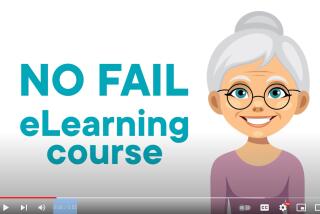Test Puts Aging Drivers Ahead of Curve : Safety: Relatively simple experimental exam could help older citizens decide when it’s time to get off the road.
- Share via
WASHINGTON — Plastered on the bumper of a pickup truck, the sticker captured the frustration of many hurried young drivers along Florida highways: “When I get old, I’m going to move up North and drive slow.”
However, researchers say the slogan unfairly indicts thousands of safe older drivers, and those moving slowly trying to be safe.
Drs. William Schiff and Rivka Oldak of New York University have been experimenting with a relatively simple test that can help older drivers decide where they need improvement and whether they can continue to drive safely.
They sit people in a chair, with brake and accelerator pedals, and use a large television screen to simulate the view through the windshield of a moving car.
It’s no fancy electronic simulator, but it’s also a lot cheaper than those machines, said Schiff, who would like to see the system available to people nationwide.
The American Automobile Assn. financed experiments in Florida, New York and Vermont. Schiff said he’s talking with officials in California and Massachusetts about doing similar tests there.
“One of the things we have demonstrated, or discovered, is that it’s not simply reflexes” that are the problem for older drivers, Schiff said in a telephone interview.
When he tested how fast people can move their foot from the accelerator to the brake, there was little difference among people of different ages, he said.
He did find a difference--sometimes significant--in the time it takes to make a decision to move the foot.
But not everyone slowed down with age. “Just because someone is older doesn’t mean they have slower reactions,” Schiff stressed.
Two other problems cropped up with some older drivers--unintended acceleration and visibility problems when facing glare.
Periods of low light and the presence of oncoming headlights tended to increase mishaps involving older drivers, Schiff found.
And they sometimes slammed a foot on the accelerator instead of the brake when suddenly confronted with a traffic hazard, such as a child or animal running into the road.
Some older people give up driving long before they have to simply because they have no way to test their skills, Schiff said.
If relatively simple testing systems were available in community centers, shopping malls, AAA offices and driver license offices, people who were concerned about their changing driving skills could test themselves, he said.
They could learn where they have problems and possible ways to compensate, such as not driving at night or in heavy rain, when they might have visibility problems.
“Or they might find out that they’re fine, which can also be reassuring,” Schiff said. “A lot of people are very concerned about driving because they are 71 or 75 or older.”
More to Read
Sign up for Essential California
The most important California stories and recommendations in your inbox every morning.
You may occasionally receive promotional content from the Los Angeles Times.












